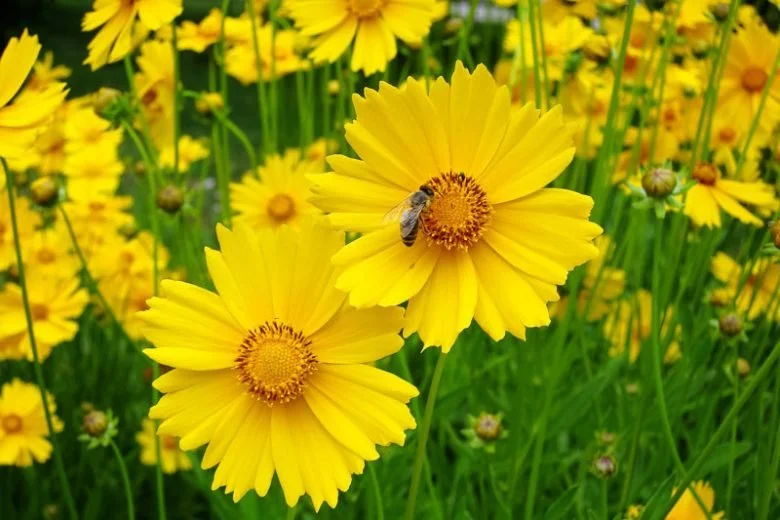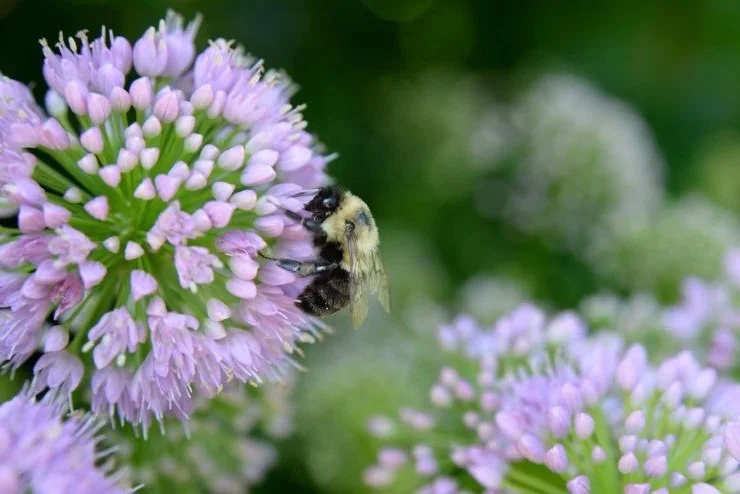Pollinator Patch favourites for sunny spots
OSEAN’s pollinator patch program has distributed close to 5,000 native perennials since the program began in 2022! From all the perennials that the pollinator patch program has given away, the favourites were: Lance-leaved Coreopsis, Pearly Everlasting, Swamp Milkweed, Nodding Onion, New England Aster and Black-Eyed Susan. But, you may wonder…what are those perennial plants? Well, this blog will teach you a bit about each of the favourite perennials, give a brief description and explain why gardeners choose to plant those compared to other plants!
Here are the top 6 plants for sunny spots. All of them are beginner friendly, as long as they are planted in a location which meets their soil and moisture requirements. And if you don’t have a sunny spot, check back on February 4th when we’ll be publishing our top picks for shady spots!
Lance-leaved Coreopsis
Pearly Everlasting
Swamp Milkweed
Nodding Onion
New England Aster
Black-Eyed Susan
Lance-leaved Coreopsis
Scientific name: Coreopsis lanceolata
Family: Asteraceae
Description of plant
1-2 feet tall
Deeply cut leaves around 3-4 inches long that creates 3 leaflets.
Yellow flower heads are around 1 - 1 ½ inches across.
Full sun / Dry to medium soil / Blooms May to June / Harvest seeds in July
The Lance-leaf Coreopsis is a native perennial that is capable of growing in several different soil types, which is why many home gardeners tend to grow these! This native plant is consistently discovered in dry and unproductive areas, where there is enough sun or slight shade. Lance-leaf Coreopsis is a short-lived plant - its life-span is around 3-5 years and sometimes slightly shorter than the expected lifetime. You may wonder…if the life expectancy is short, how can this plant reproduce at a rapid rate? Well, Lance-leaf Coreopsis provides a plentiful number of seeds in the flowerhead that you can take out and then plant them so that they can grow into another beautiful Lance-leaf Coreopsis flower! Another way that this can be done is to divide the plant every few years around fall by softly pulling or teasing the roots away from each other using your hands, or by cutting the roots with a sharp tool, or using forks back-to-back in order to pull the roots apart. The more these plants grow, the more seeds and pollinators arrive such as butterflies, native bees and other beneficial insects!
Pearly Everlasting
Scientific name: Anaphalis margaritacea
Family: Asteraceae
Herbaceous perennial wildflower
Stems up to 3 feet tall
Long and slender leaves with a green surface colour with thick white undersides
Full sun to part shade
Medium soil humidity / Blooms July to August / Harvest seeds October to November
Pearly Everlasting is one of the pollinator patch program’s favourite plants which consists of a daisy-like flower with a yellow flower head and white hair-like petals. This plant is capable of growing up to 24 inches and will relatively grow quickly and bloom in the first year of the plant’s life. In order for a pearly everlasting to grow, it is preferred to plant it in slightly gravelly soil (This plant could tolerate poor soil or clay soil as well). This perennial plant grows better in the sun or in slight shade with slightly moist or even dry soil. To make sure that you are adding enough water, a pearly everlasting plant should be watered about 2-3 times a month in the summer depending on the weather conditions. These plants tend to last all throughout the summer and fall in both big and small spaces, and are an easy plant to propagate by division. The pearly everlasting is a must for pollinators! It attracts bees and native bees, adult butterflies, birds and is a host plant for American lady caterpillars.
Swamp Milkweed
Scientific name: Asclepias incarnata
Family: Apocynaceae
Pink star clusters
Grows up to 3-4 feet tall (90-120 cm)
Seed pod is 3-4 inches long
Full sun to part shade
Wet to medium soil / Blooms July to August / Harvest seeds in August
Swamp milkweed is one of the pollinator Patch Program’s favourite native perennial plants and gardeners as well! This perennial is known for its pink and purple star-like flower clusters that bloom around early summer. A few things about swamp milkweed is that they prefer to grow in full sun or part-shade and thrive in medium to moist soils. They are also capable of growing well in poor, dry or grainy soils! Some of the thirsty pollinators that are attracted to the milkweed are monarch butterflies, bumble bees and a diversity of insects that provide food for birds.
If swamp milkweed isn’t right for your growing space, there are several other native species which need different conditions, have different heights and flowers. All of them are hosts for the monarch butterfly! Here is an article from In Our Nature with more information about our native-to-Ontario milkweed varieties.
Nodding onion
Scientific name: Allium cernuum
Family: Amaryllidaceae
Max height 18”
Bell-shaped white flowers that change to purple once it has matured
Delicate grass-like foliage that come in clusters
Full sun to part shade
Dry to medium soil / Blooms June to August / Harvest seeds September to October
Nodding onion is one of Canada’s native perennial plant species that is capable of growing in areas where there is moisture and where the soil is more loam with a lot of nutrients that will help them spread quickly! Nodding onion is still capable of growing in dryer soils, but it is still preferred to be in moist soil and likes to be in full sun or part shade. Nodding onion is a very great plant that most gardeners use to attract pollinators. It will attract butterflies and hummingbirds, and certain types of bees such as sweat bees, bumble bees, and honeybees.
New England Aster
Scientific name: Symphyotrichum novae-angliae
Family: Asteraceae
Pink or purple flowers
Can grow up to 6 feet tall
Full sun to part shade
Medium soil humidity / Blooms August to September / Harvest seeds in October
New England Aster is an excellent beginner gardener’s choice! It prefers to grow in full sun (around 6 to 8 hours of proper sunlight) and moist, acidic but well-drained soil. It can bloom very quickly that same year around fall! Another reason the New England-Aster is a wonderful plant is because it attracts many pollinators such as butterflies, native flies, and a wide variety of native bees!
Black-eyed Susan / Rudbeckia
Scientific name: Rudbeckia hirta
Family: Asteraceae
Ray-like flower colours can range from yellow to dark orange
Grows up to about 3 feet tall
Composite flower heads
dark conical centres
Small, dark brown columnar seeds that become thinner
Full sun to part shade
Dry to medium soil / Blooms June to September / Harvest seeds in July
Black-eyed Susan is one of the Pollinator Patch Program’s favourite native perennial plants, as they are extremely easy to grow. A few elements that they need in order to flourish are full sun, and a good enough amount of water, where the acidic soil type stays moist or slightly dry to well-drained. Black-eyed Susan bloom from early summer to the beginning of the fall. An amazing thing about the Black-eyed Susan is that they are capable of propagating on their own through reseeding themselves, or another way which is division.
Thank you for reading about the Pollinator Patch Program’s favourite sun perennials! These descriptions are here to help gardeners and future learners of the importance of understanding what certain plants need to grow, flourish, and thrive!
And if you’d like to keep exploring, check out our list of favourite native plant resources.






